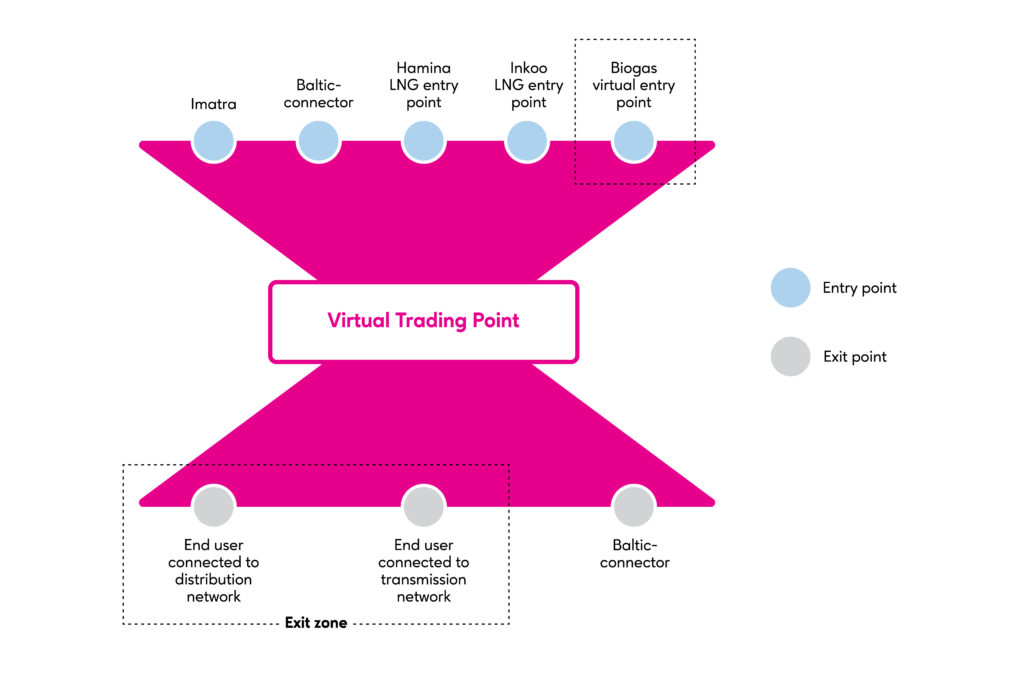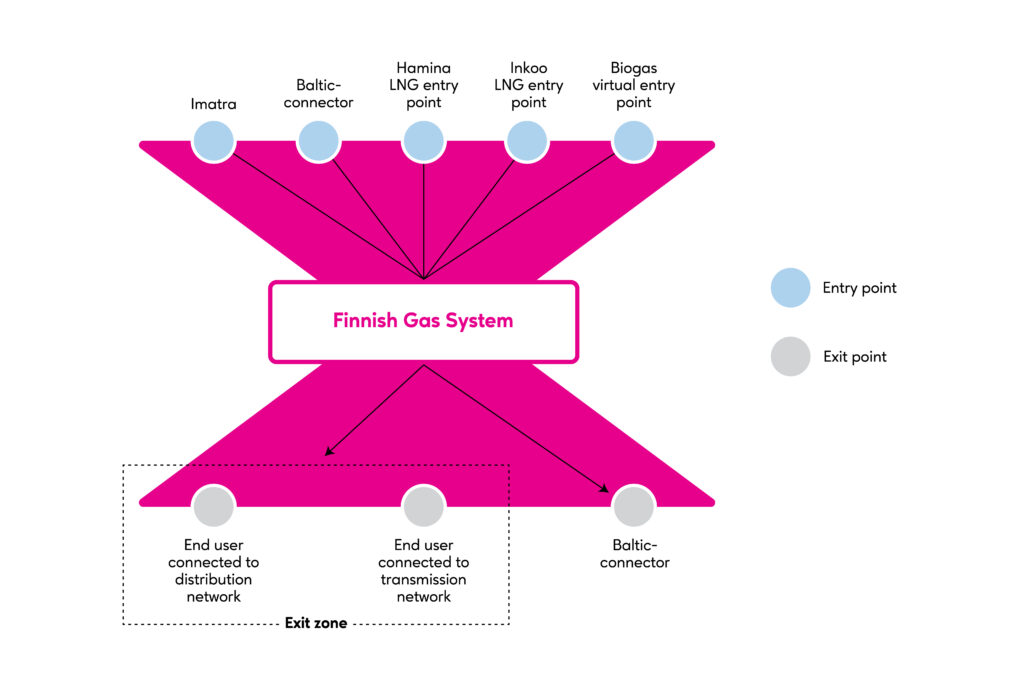Market model
The Finnish gas market was opened to competition on 1 January 2020. Following the opening of the gas market, third parties have equal and non-discriminatory opportunities for network access in the natural gas transmission and distribution networks. An entry-exit system in accordance with EU gas market legislation is applied in Finland.
- Contact us:
- customerservice@gasgrid.fi
Wholesale market products
Trade in gas energy and transmission capacity takes place in the wholesale market. The transmission system operator (TSO) Gasgrid Finland is responsible for selling transmission capacity in the system and the shippers and traders are responsible for selling gas energy.
Gas energy means a specific quantity of gas in kilowatt hours (kWh), measured in terms of the higher heating value (HHV, gross calorific value). Trading in gas can take place via a gas exchange or over the counter (OTC) with another market participant.
Transmission capacity means the right to transmit above-mentioned gas energy in the transmission network, expressed in the unit of kWh/h. Capacity is bought from Gasgrid Finland.
Entry-exit system
In the entry-exit system, gas flows into the Finnish gas system via entry points and out of the system via exit points. The entry points are the Imatra Entry Point via which gas is imported from Russia, the Inkoo Entry Point via which gas is imported from Estonia, and the aggregated virtual entry point formed by biogas plants.
Gas exits the system in the exit zone. Gas can be exported from Finland to Estonia via the Balticconnector pipeline. In the exit zone, gas is transmitted from the transmission network to an end user or to a lower-pressure network.
In the future, liquefied natural gas (LNG) terminals may also become part of the Finnish entry-exit system.
Gasgrid Finland is responsible for maintaining the Virtual Trading Point (VTP) where all gas transfers taking place in the market are registered. In practice, this VTP is an information system where market participants report their transfers of gas energy. In the Finnish gas market model, all gas injected into and withdrawn from the market area goes via the VTP. In the entry-exit system, physical and commercial gas flows are separated from each other, which enables efficient operations in the gas market.

Capacity is booked for entry and exit points so that the gas energy required can be transmitted physically in the transmission system. Among the market participants, shippers are able to receive capacity and trade in capacity.

Biogas virtual entry point is a virtual entry point to which all biogas entry points belong, regardless of which network they are connected to. Shippers use the biogas virtual entry point to reserve capacity for biogas entry points.
1 of 5Entry point is a metered or non-metered physical point where gas is physically injected into the natural gas system or a virtual point where a shipper or trader receives gas from the Virtual Trading Point or injects (bio)gas or LNG produced into the system.
2 of 5Exit point is a metered or non-metered physical point where gas is physically transmitted from the natural gas system or a virtual point where a shipper or trader delivers gas to a buyer from the Virtual Trading Point or a gas exchange.
3 of 5Exit zone covers all end users connected to the Finnish gas system. Shippers need not order capacity separately for each end user. Instead, they may combine their capacity orders so that sufficient capacity is ordered for their customer portfolio.
4 of 5Exit zone covers all end users connected to the Finnish gas system. Shippers need not order capacity separately for each end user. Instead, they may combine their capacity orders so that sufficient capacity is ordered for their customer portfolio.
5 of 5Nominations are notifications of quantities of gas transmitted.
Shippers are required to submit nominations stating the quantities of gas that they intend to have transmitted within the capacity obtained by them via the Balticconnector, Imatra Entry Point and, as regards liquefied natural gas (LNG), at LNG entry points. The same point can be used by multiple shippers to receive gas. Nominations are used by the transmission system operator (TSO) to settle the shippers’ commercial balance. A characteristic feature of the Finnish market model is that no nominations are required for the exit zone. Instead, a capacity order is a sufficient measure. As each delivery site of the exit zone can only have one shipper, the quantity of gas for that shipper can be established on the basis of metering.
Allocation
Allocation means the quantity of gas allocated to a market participant. Allocation is used as the basis for determining the shipper’s payments in the transmission network and as initial data for balance settlement. In the exit zone and at biogas entry points, measurement data is used as shippers’ allocation. However, at the Balticconnector, Imatra Entry Point and LNG entry points the nominations are used as the allocation.
Balancing
Gasgrid Finland is responsible for balancing in the Finnish gas system. The balancing period is the gas day, which commences at 7:00 am and ends at 7:00 am on the following day. A shipper’s or trader’s injections and withdrawals of gas energy must be of equal quantity over the period in question, that is, participants are responsible for their own commercial balance in the market.
A shipper or trader may act as a balance responsible party by itself or outsource balance responsibility to another shipper or trader. The market model enables multiple ways of achieving balance as, in addition to forming and merging balance groups, participants may buy/sell gas over the counter between each other or on a gas exchange or, alternatively, export gas via the Balticconnector.
Gasgrid Finland is responsible for the physical balance of the Finnish gas system. This takes place by optimising the level of pressure.
Supply chain
Shippers may act as importers/exporters of gas. A shipper may deliver a quantity of gas directly to an end user (such as a power plant or industrial facility) connected to the transmission network, sell a quantity of gas imported by the shipper to another shipper or trader at the Virtual Trading Point or on a gas exchange and/or alternatively sell the quantity of gas to a retailer. The product sold by a shipper to a retailer or end user also contains the gas transmission charge levied by the transmission system operator (TSO) from the shipper.
Distribution system operators (DSOs) levy the distribution tariff from distribution network end users. A DSO and a retailer may agree on joint invoicing. Gasgrid Finland operates as taxpayer, which means that excise duty is passed on through invoicing to transmission network end users and DSOs who then pass it on through invoicing to distribution network end users.
- Read more:
- Chart of Delivery relationships



